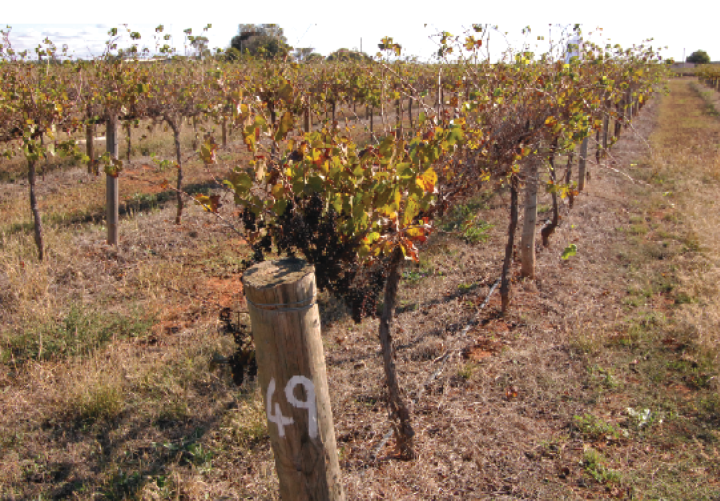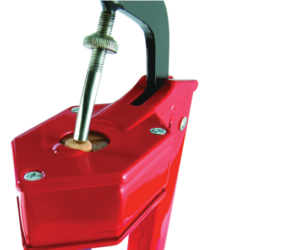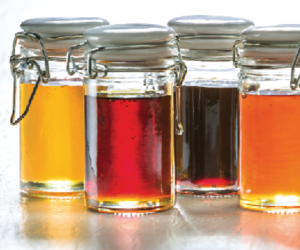
Here is one truism of farming: Being prepared is always preferable to trying to fix an unexpected problem. Understanding the water needs of a grapevine is an important step to using as much supplemental irrigation in your small vineyard as needed, but not an amount that is either wasteful or actually reduces the quality of your backyard wine.
There’s good news for winegrape growers in a drought! Grapevines are extraordinarily efficient in their use of water. Worldwide, it takes only a few gallons (liters) of water to produce a bottle of wine, while it takes more than 400 gallons (~1,500 L) of water to produce a pound of beef. Grape growers have an intrinsic advantage to exploit.
So here’s the plan. Let’s just assume that nature will deal us a difficult hand in 2015 and we need to be prepared for another dry spring and summer. Our goals are to find the easiest and most cost-effective ways to set up and manage a vineyard that uses minimal water resources.
To that end we should explore:
• How a grapevine uses water
• What rootstocks can provide drought resistance
• Understanding the basics of irrigation
• How much water to give our vines to make the best wine
• Some considerations and best-practices for vineyard management during a drought cycle
How a Grapevine Uses Water and Rootstock Considerations
Drought-tolerant rootstocks may seem like an excellent choice for all vineyards in these dry times. Why would you not want a root system that sips instead of gulps? In fact there are reasons! Using irrigation as a tool for moderating the vine’s cycle and fruit sugar levels (Brix) is increasingly difficult using highly drought-resistant grapevine rootstock. If you turn off the water and expect a result, you may be disappointed by a slow response from a stock that you planted purposefully to slow down water usage.
How do specific rootstocks actually work this water-conserving magic? The answer is a little complicated, but I’ll try to simplify it.
First, evolution has allowed grapevines, mostly from the United States, and commonly from arid regions of riparian (river-environments) Texas, to develop an ability to survive long periods of drought and produce fruit just palatable enough to attract animals that will spread the vine’s seed. These American vines (used now for rootstocks) adapted to areas far more dry and drought-prone than the same area (Transcaucasia and Europe) where the Eurasian grapevine evolved.
Second, a surprising benefit of the phylloxera scourge in the late 19th century was determining that American rootstock not only protects a vine’s roots from nasty American bugs that never existed in Europe before then, but also has secondary characteristics that can influence drought tolerance.
Third, evolution tweaks physical, hormonal and nutritional factors in the vine’s physiology that allow for extreme efficiency in using available groundwater at root level. An example of physical factors would include minimal hydraulic resistance to water flow in dry conditions, restricting vine vigor or promoting deep root exploration. An example of hormonal factors would be maintaining photosynthesis efficiency under low water availability, preventing leaf-drop in low-water conditions or promoting stomatal closure to limit the amount of water vapor the vine is giving off. Lastly, nutritional factors could include moderating chlorophyll levels for optimum carbohydrate production for growth in drought conditions or restricting vine vigor. These two factors are usually both nutritional and hormonal in their evolutionary development.
Next let’s look at some preferred rootstocks that are known for their drought tolerance:
• 110 (R)ichter
• 140 Ruggeri
• 1103 (P)aulsen
• 5C
• 99 (R)ichter
And some rootstocks to avoid in drought-prone areas:
• 3309
• 420A
• 5BB
• 101-14
• Riparia Gloire
Using Irrigation Wisely
Irrigation is a modern blessing for vineyards. One reason why European wines vary so much vintage to vintage is that many of the most vaunted wine regions in the world do not allow mature vineyards to be irrigated. In this way, the vines are wholly dependent on the soil profile being fully charged by winter rains, and then they also need supplemental rainfall in the growing season for the vines to bring in a ripe crop.
Irrigation is probably the most important tool we have for manipulating the vine’s vigor and cycle so that it creates the style of wine that we desire. In some regions, like most of California, wine production would be impossible without supplemental irrigation. Other regions, such as the Willamette Valley of Oregon, generally receive enough rainfall throughout the year to produce good winegrapes without supplemental irrigation. If you live in an area that gets around 25 inches (64 cm) or more of winter/spring rainfall, and an additional 5–10 inches (13–25 cm) from April to October, your vines may not need a watering system at all. Clean rainwater is always superior to irrigation (ground) water, so if you can grow a vineyard without irrigation, you can plan on cutting your installation bill by at least 50%.
Concepts in Vineyard Irrigation
In dry areas where vines are dependent on irrigation, use 3–5 gallons (11–19 L) per plant per week as a starting point. March through May, maybe 2–3 gallons (8–11 L) is plenty, or none if you received good winter rains. June through August may need 3–7 gallons (11–16 L) per week. Reduce the irrigation as harvest nears, but keep the vines viable, with leaves healthy enough to mature a crop. Dump 10–20 gallons (38–75 L) on each plant immediately after harvesting the vines. Vines go through a rapid period of root growth after harvest.
Before applying water to your young vines, have your water tested at an agricultural laboratory to make sure it’s suitable for irrigation. Problems to look for are high salt content (reduction of vigor to the point of vine death is possible), hard water, which can clog drip emitters, and high chlorine content (often found in municipal water) that can destroy benefical microbes.
You can measure real-time soil moisture by digging a hole with a shovel, using an irrometer (tensiometer) or a soil probe from a farm supply store, or watching the relationship between the growing tips of the vines and the tendrils (curly growths that grab onto the trellis wires) next to the growing tip. A vine that has tendrils that stick out farther than the growing tip is generally considered to have ample water (see photo on page 59). As the tendrils pull back even with the growing tip, the vine is beginning to undergo some water stress. Proper water status in your vines will also manifest in leaves that lie at a 90-degree angle to the petiole (stalk attaching the leaf to the blade). If the leaf is drooping to an acute angle in relation to the petiole, that means there is water stress.
A vine uses the most water (up to 10 gallons/38 L a day if available) during the last two weeks of July, and uses the least (half a gallon/1.8 L or less) in early April. This does NOT mean to water your vines 10 gallons (38 L) a day in July — watch the growing tips/tendrils and only up the water if the leaves begin to droop. Also expect your tendrils at the shoot tip to pull back as the vine changes from vegetative growing cycle to fruit ripening cycles in the summer. This is normal and expected.
Never apply more water than can be totally absorbed by the soil within 48 hours.
Clay-based soils hold far more water than sandy or sandy loam soils. Reduce water use by a third in heavy clay soils and add up to 30% to your irrigation totals in highly sandy soils.
Deficit Irrigation: There are times when having little or no water in the soil can increase wine quality. Drying the soil out as the crop finishes flowering and set has proven to minimize berry size, which can increase a wine’s color and concentration. (Less juice and more skin in the fermenter) Soil dryness before veraison (or berry softening), will tell the vine to stop its vegetative growth cycle (focusing nutrients on shoots and leaves) and focus on ripening the crop. In a vineyard with excessive growth (vigor), allowing the soil to dry out early in the spring, as the vine comes out of dormancy, will keep the vine from producing rank growth. And of course turning the water off the last few days/weeks before harvest will likely hasten ripening, and is something most vineyards do. Be careful with turning the water off too early, though. A grapevine without green leaves will not evolve the true ripeness of the fruit, it will only dehydrate.
Leaching salts: Applying water from ground or municipal sources adds a lot of salts to the root zone. Heavy winter rains are needed yearly to flush all the accumulating salts away from the roots, where they can attach and stifle a vines’ growth. In periods of drought, lower yields can normally be attributed to these salts coating the root hairs and seriously hampering a vine’s ability to grow a healthy crop of ripe fruit.
Weeds use irrigation too. If you have drip emitters (see photo at left), you will notice that weed growth will be rank around the emitter. Irrigation will make it necessary to do more weed control, so sharpen your hoe or hire the grandkids. Agricultural labor builds character.
Overhead sprinklers that soak the vines are generally not a wise system for vineyard watering. They increase mildew pressure, rot pressure, and less of the water makes it to the vines’ roots, and much of the water can evaporate or cause extra weed growth in the middle of the vine row. Pressure compensating drip-emitters (I always recommend the Netafim brand) are my favorite way to apply water to a vineyard. They apply a measured amount of water per hour (e.g. 2 liters, 4 liters or 8 liters) and apply the same amount of water at the top of a hill (low pressure) and at the bottom of the hill (higher pressure).
Considerations and Best Practices
Almost all vineyards can benefit from water-saving techniques. Here are few to consider:
• Apply water with a drip system and always at night. Watering at night can double your irrigation efficiency, as water has much better penetration into the soil when it is not being baked into vapor by the sun.
• Choose drought-resistant rootstocks and vine varieties that ripen earlier to avoid late-season irrigation.
• Learn the signs of water stress in grapevines (or buy a grape leaf pressure-bomb) and only apply water in your vineyard when the vines need it. If you are in an area where grapevines grow healthy and ripen a crop without supplemental irrigation, celebrate! You don’t need to worry about all of this “I grow vines in a desert” nonsense.
• Plant your vineyard on a hill where the cold air/frost can move to a lower part of the property and drain away from your vines. This will eliminate the need for overhead sprinklers for frost protection and can save thousands of gallons or liters of water.
• Monitor the conditions in your vineyard and keep records. Measure the rainfall at your property and write down your findings. Keep irrometers/tensiometers in good working order and apply water only when the ground is drying out between 18 and 36 inches (46 and 91 cm), where the vines’ roots do most of their work. Measure how much water is being delivered at various parts of your vineyard with a graduated bucket or pitcher and a stopwatch. Try to get all sections of your vineyard to receive the same amount of irrigation per hour.
• Learn how weather and heat waves impact your soil moisture. Once you’ve done this for five to ten years, it will become second nature how much your vines need.
• Experiment with deficit irrigation in your own vineyard. Try to give your backyard vines 10% less water each week and see how it impacts vine vigor and fruit quality. You may be surprised to find that wine quality increases when you turn the water off at various times of the year.
“Wine is sunlight held together by water.” – Galileo
Water is what makes this planet so special. All life needs water, which is a great reason to conserve. Pay attention in your backyard, take some notes, experiment with techniques, and get your vineyard water wise!






